

The Story Of The Alberta Oil Sands. Oil Sands Discovery Centre. Water Pollution: Definition, Types, and Sources - Video & Lesson Transcript. Oil Spill Information for Kids. Important facts and tips on water pollution for children. Important facts of water pollution. 40% of America’s rivers and 46% of America’s lakes are too polluted for fishing, swimming, or aquatic life. 1.2 trillion gallons of untreated sewage, storm water, and industrial waste are discharged into US waters annually.
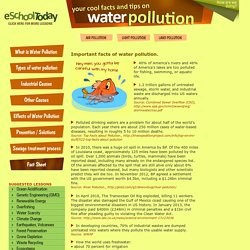
Source: Combined Sewer Overflow (CSO), stormwater/cso.pdf Polluted drinking waters are a problem for about half of the world’s population. Each year there are about 250 million cases of water-based diseases, resulting in roughly 5 to 10 million deaths. In 2010, there was a huge oil spill in America by BP. In April 2010, The Transocean Oil Rig exploded, killing 11 workers. In developing countries, 70% of industrial wastes are dumped untreated into waters where they pollute the usable water supply. How the world uses freshwater: • about 70 percent for irrigation • about 22 percent for industry • about 8 percent for domestic use Source: World Water Assessment Programme (WWAP)
Oil Spills: Sad But True. Imagine you’re a killer whale.
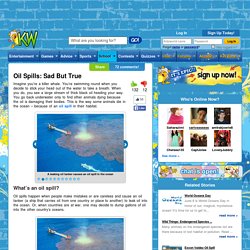
You’re swimming round when you decide to stick your head out of the water to take a breath. When you do, you see a large stream of thick black oil heading your way. You go back underwater only to find other animals dying because the oil is damaging their bodies. This is the way some animals die in the ocean – because of an oil spill in their habitat. Pros and cons: Alberta oil sands. A scientific panel said Tuesday that weaknesses in measuring pollution from the Alberta oil sands must be corrected.

Pollution is one argument against the oil sands development. Global News takes a look at the pros and cons involved in developing the oil sands. Economic Contribution - Oil Sands Today. When most Canadians think of oil sands, they think of Alberta.
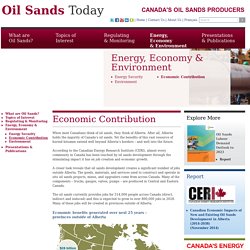
After all, Alberta holds the majority of Canada’s oil sands. Yet the benefits of this vast resource of buried bitumen extend well beyond Alberta’s borders – and well into the future. According to the Canadian Energy Research Institute (CERI), almost every community in Canada has been touched by oil sands development through the stimulating impact it has on job creation and economic growth. Both Sides of the Keystone XL Debate Have It All Wrong. Watching the Keystone XL pipeline debate has been like watching a train wreck.
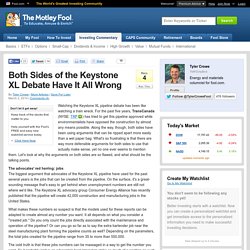
For the past five years, TransCanada (NYSE: TRP ) has tried to get this pipeline approved while environmentalists have opposed the construction by almost any means possible. Along the way, though, both sides have been using arguments that can be ripped apart more easily than a wet paper bag. What's so frustrating is that there are way more defensible arguments for both sides to use that actually make sense, yet no one ever seems to mention them. Let's look at why the arguments on both sides are so flawed, and what should be the talking points.
Oil Sands Truth: Shut down the Tar Sands. Bird deaths reported on Alberta oil sands tailing ponds. More than 100 migrating birds have been found dead after they landed on oil sands tailing ponds this week.
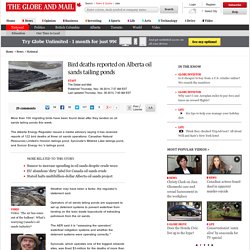
The Alberta Energy Regulator issued a media advisory saying it has received reports of 122 bird deaths at three oil sands operations: Canadian Natural Resources Limited’s Horizon tailings pond, Syncrude’s Mildred Lake tailings pond, and Suncor Energy Inc.’s tailings pond. Weather may have been a factor, the regulator’s statement said. Operators of oil sands tailing ponds are supposed to set up deterrent systems to prevent waterfowl from landing on the toxic waste byproducts of extracting petroleum from the oil sands. The AER said it is “assessing the operators’ waterfowl mitigation systems and whether the deterrent systems were operating correctly.”
Syncrude, which operates one of the biggest oilsands sites, was fined $3-million for the deaths of more than 1,600 ducks when they landed on its tailings pond in 2008. What’s the Problem with the Tar Sands? - Tar Sands Solutions Network. Canada’s tar sands is the biggest industrial project on earth, and the pace and scale of industry's continued plans for expansion is astonishing.
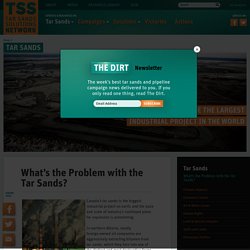
In northern Alberta, mostly foreign-owned oil companies are aggressively extracting bitumen from tar sands, which they turn into one of the dirtiest and most destructive forms of energy on the planet. In the process, they are creating serious social, economic and environmental problems in Alberta, North America and all over the world. Climate, air and water impacts Tar sands development releases an inordinate amount of climate-warming greenhouse gases into the atmosphere. Development also pollutes the land, air, and water with dangerous levels of toxic chemicals in northern Alberta and along leak-prone pipeline routes that carry this highly corrosive cargo through communities and waterways across North America. Wildlife and human rights impacts Threats to economy and democracy.
It will take more than rebranding to make tar sands oil "ethical" Alberta tar sands contribute to about five per cent of Canada's greenhouse gas emissions (Credit: Pete Williamson via Flickr).
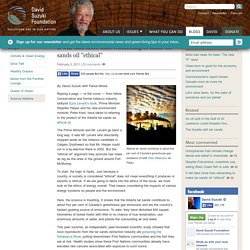
By David Suzuki with Faisal Moola Ripping a page — or the cover — from fellow Conservative and former tobacco industry lobbyist Ezra Levant's book, Prime Minister Stephen Harper and his new environment minister, Peter Kent, have taken to referring to the product of the Alberta tar sands as ethical oil. The Prime Minister and Mr. Levant go back a long way. It was Mr. To start, the logic is faulty. Here, the science is troubling. This past summer, an independent, peer-reviewed scientific study showed that toxic byproducts from the tar sands extraction industry are poisoning the Athabasca River, putting downstream First Nations communities and the fish they eat at risk.
What are Oil Sands? Canada’s energy future lies in the oil sands.

Our country possesses approximately 174 billion barrels of oil that can be recovered with today’s technology. Of that number, 169 billion are located in the oil sands. What is Bitumen? Oil sands are a mixture of sand, water, clay and bitumen. Bitumen naturally occurs along theriver banks and in the Athabasca River area. Bitumen is oil that is too heavy or thick to flow or be pumped without being diluted or heated – at 11 degrees Celsius bitumen is as hard as a hockey puck.
Quick Facts - Oil Sands Today. Solar Energy 101 - Green Mountain Energy Company. About Solar Energy Solar energy is generated using the sun’s powerful rays.
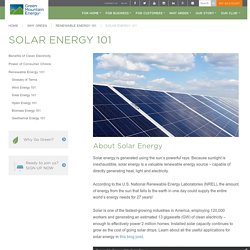
Because sunlight is inexhaustible, solar energy is a valuable renewable energy source – capable of directly generating heat, light and electricity. According to the U.S. National Renewable Energy Laboratories (NREL), the amount of energy from the sun that falls to the earth in one day could supply the entire world’s energy needs for 27 years! Solar is one of the fastest-growing industries in America, employing 120,000 workers and generating an estimated 13 gigawatts (GW) of clean electricity – enough to effectively power 2 million homes.
How do solar panels work? - Science Questions. A solar panel turns the sun’s light into electricity! We see electricity at work every day. For instance, when you turn on a lamp, electrons move through the cord and light up the bulb. That flow of electrons is called electricity. One solar panel is made up of many small solar cells. Each of these cells uses light to make electrons move. When the light hits an electron in the first layer, the electron jumps to the second layer. The cars in this photo get their power from the flat solar panels on top. How Solar Energy Panels Work. Wind Turbines - How does it actually work? Investment? 300 Years of FOSSIL FUELS in 300 Seconds.
Fossil Fuel Facts. Fossil Fuel Formation Complete. Where do We Get Oil from? Kids Encyclopedia. Fossil fuels. Energy Guide for kids. What are fuels? How do you get energy from them? Now this is where humans are different from all other life. You have learned how you can use fuels to make energy to power machines like cars, planes and computers. This way, you don’t have to work so much and you can stay warm without the fat, fur or feathers that other animals have.
You get the fuel to make all this extra energy mostly by digging it out of the ground and burning it. Fossil fuels - made by billions of tiny plants and animals which lived millions of years ago. I'm sure you know what these fuels are: These fossil fuels all come from underground; inside the Earth's crust. Keeping homes and offices warm in winter and cool in summer transport: you know... cars, buses, some trains, ships and aircraft Fuels for heating can be any fossil fuel though people mostly use oil or gas because they're easier and less dirty. Where energy comes from. What are they? Find out more about coal, oil, natural gas and fossil fuels.